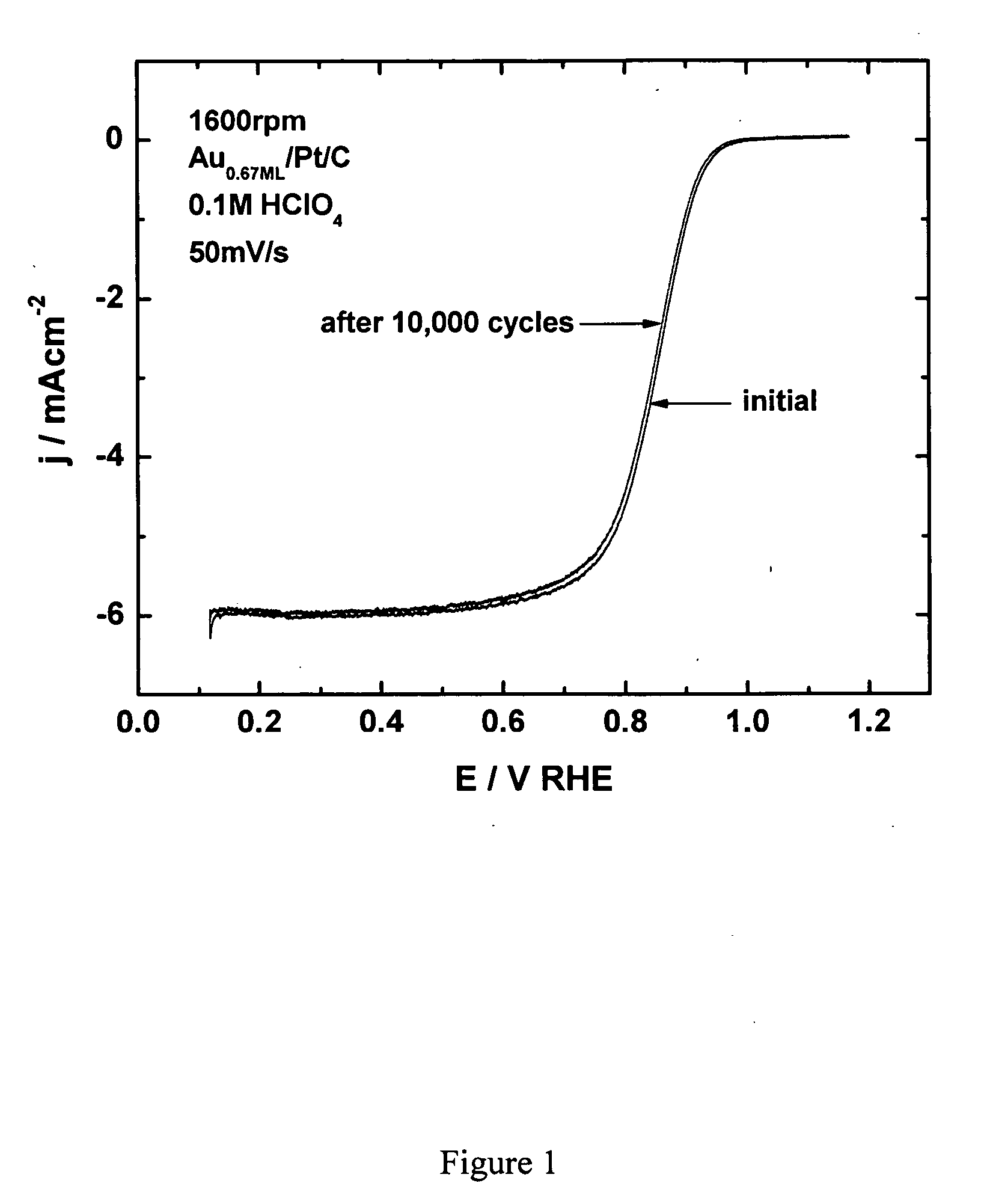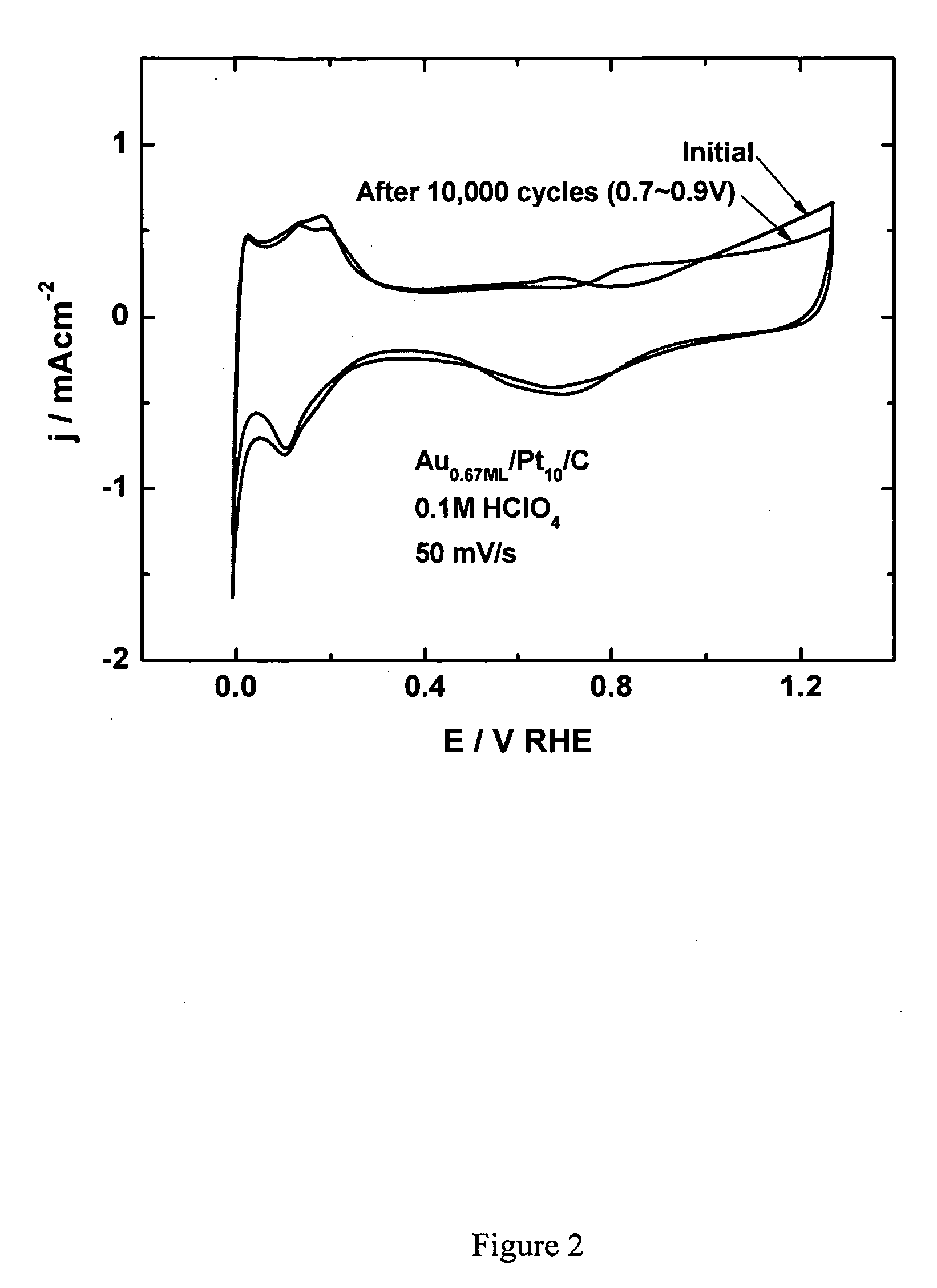Electrocatalysts having gold monolayers on platinum nanoparticle cores, and uses thereof
a technology of electrocatalysts and platinum nanoparticles, which is applied in the direction of catalyst activation/preparation, metal/metal-oxide/metal-hydroxide catalysts, etc., can solve the problems of inability to stabilize the platinum electrocatalyst in the cathode during the operation of the fuel cell, concomitant dissolution of platinum ions, and depletion of platinum from the cathode, so as to maintain the efficiency of the fuel
- Summary
- Abstract
- Description
- Claims
- Application Information
AI Technical Summary
Benefits of technology
Problems solved by technology
Method used
Image
Examples
example 1
Preparation of Gold-Coated Platinum Nanoparticles
[0199] Gold-coated platinum nanoparticles (also denoted as Au / Pt) were prepared by depositing an atomic monolayer of gold onto platinum nanoparticles. The gold was deposited using the redox displacement method described by Zhang et al. (Ibid.).
[0200] In the process, a monolayer of copper (copper adlayer) was deposited onto platinum nanoparticles of circa 3-10 nm diameter by placing the nanoparticles on a suitable electrode and applying a suitable reducing potential to the electrode immersed in a ˜50 mM CuSO4 / 010M H2SO4 aqueous solution in a nitrogen atmosphere. The electrode with copper-coated Pt nanoparticles was rinsed with purified water to remove copper (2+) ions in solution. To displace the copper monolayer with a gold monolayer, the electrode with Pt nanoparticles was then immersed in a ˜1.0 mM aqueous solution of a suitable gold salt (e.g., HAuCl4). After a 1-2 minute immersion to completely replace copper by gold, the elect...
example 2
Electrocatalytic Activity Measurements of Gold Monolayer-Coated Platinum Nanoparticles
[0203] Platinum dissolution from platinum electrocatalyst nanoparticles on oxygen-reducing cathodes can be prevented by placing a submonolayer-to-monolayer of gold onto the platinum nanoparticles. Since gold is oxidized at considerably more positive potentials than platinum (0.75 V for Pt vs. 1.3 V for Au), it is believed that the gold-coated platinum electrocatalyst has a positively shifted platinum oxidation. Such a positively shifted platinum oxidation would account for the increase in stability observed for the gold-coated platinum electrocatalyst.
[0204] In addition to the noted stability, surprisingly, the oxygen reduction of platinum covered by a submonolayer-to-monolayer of gold occurs with almost identical kinetics for platinum. Accordingly, the electrocatalytic activity of platinum in these gold-coated electrocatalysts remains intact and is not compromised by the gold coating. A similar...
PUM
| Property | Measurement | Unit |
|---|---|---|
| size | aaaaa | aaaaa |
| size | aaaaa | aaaaa |
| size | aaaaa | aaaaa |
Abstract
Description
Claims
Application Information
 Login to View More
Login to View More - R&D
- Intellectual Property
- Life Sciences
- Materials
- Tech Scout
- Unparalleled Data Quality
- Higher Quality Content
- 60% Fewer Hallucinations
Browse by: Latest US Patents, China's latest patents, Technical Efficacy Thesaurus, Application Domain, Technology Topic, Popular Technical Reports.
© 2025 PatSnap. All rights reserved.Legal|Privacy policy|Modern Slavery Act Transparency Statement|Sitemap|About US| Contact US: help@patsnap.com


